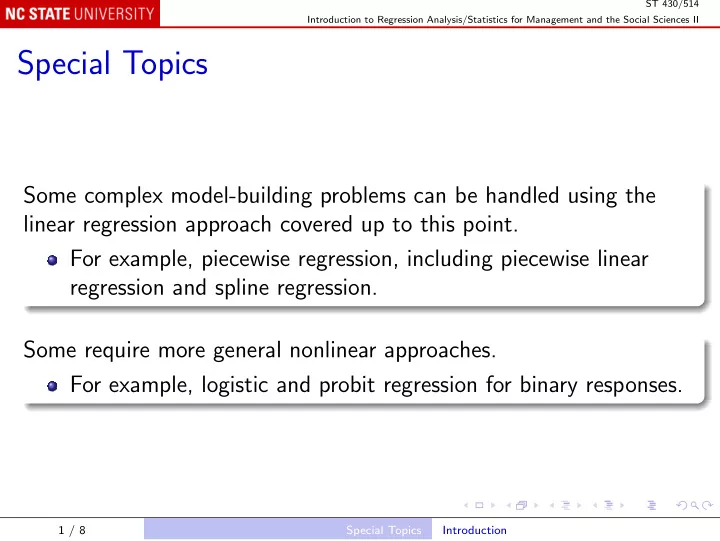

ST 430/514 Introduction to Regression Analysis/Statistics for Management and the Social Sciences II Special Topics Some complex model-building problems can be handled using the linear regression approach covered up to this point. For example, piecewise regression, including piecewise linear regression and spline regression. Some require more general nonlinear approaches. For example, logistic and probit regression for binary responses. 1 / 8 Special Topics Introduction
ST 430/514 Introduction to Regression Analysis/Statistics for Management and the Social Sciences II Piecewise Regression Consider the compressive strength of concrete: cement <- read.table("Text/Exercises&Examples/CEMENT.txt", header = T) with(cement, plot(RATIO, STRENGTH)) RATIO is the ratio of water to cement (by mass). The compressive strength decreases as the ratio increases. We could try a quadratic model: lq <- lm(STRENGTH ~ RATIO + I(RATIO^2), cement) summary(lq) curve(predict(lq, data.frame(RATIO = x)), add = TRUE) 2 / 8 Special Topics Piecewise Regression
ST 430/514 Introduction to Regression Analysis/Statistics for Management and the Social Sciences II Sometimes, theory may suggest that a relationship is a straight line, but with different slopes in different parts of the data. For example, β 0 + β 1 x x ≤ ξ, E ( Y ) = 0 + β ∗ β ∗ 1 x x > ξ. Usually we want the model to be continuous at x = ξ : β 0 + β 1 ξ = β ∗ 0 + β ∗ 1 ξ Instead of imposing this as a constraint, the model is usually reparametrized as E ( Y ) = β 0 + β 1 x + β 2 max ( x − ξ, 0) . 3 / 8 Special Topics Piecewise Regression
ST 430/514 Introduction to Regression Analysis/Statistics for Management and the Social Sciences II In the example, suppose the theory suggests that ξ = 70 is the critical ratio: xi <- 70 lp70 <- lm(STRENGTH ~ RATIO + pmax(RATIO - xi, 0), cement) summary(lp70) curve(predict(lp70, data.frame(RATIO = x)), add = TRUE, col = "red") Note the slightly higher R 2 and R 2 a . 4 / 8 Special Topics Piecewise Regression
ST 430/514 Introduction to Regression Analysis/Statistics for Management and the Social Sciences II In fact, ξ = 65 gives even higher R 2 a , but is not suggested by theory. We can treat ξ as an additional parameter, to be estimated, but the model is no longer a linear regression model. Nonlinear fitting shows that ξ is not significantly different from 70. 5 / 8 Special Topics Piecewise Regression
ST 430/514 Introduction to Regression Analysis/Statistics for Management and the Social Sciences II Sometimes the lines are not constrained to be continuous. For example, reading scores: rScores <- read.table("Text/Exercises&Examples/READSCORES.txt", header = T) with(rScores, plot(Age, ReadScore)) To fit separate lines for Age ≤ 14 and Age > 14, include the interaction of Age and the indicator variable for Age > 14: l14 <- lm(ReadScore ~ Age * (Age > 14), rScores) summary(l14) curve(predict(l14, data.frame(Age = x)), to = 14, add = TRUE, col = "blue") curve(predict(l14, data.frame(Age = x)), from = 15, add = TRUE, col = "blue") 6 / 8 Special Topics Piecewise Regression
ST 430/514 Introduction to Regression Analysis/Statistics for Management and the Social Sciences II Spline Functions The continuous piece-wise linear model that was used for the cement example is a simple example of a spline function . The break-point ξ is a knot . Several knots could be used, if an argument could be made for them. For each knot ξ j , include max ( x − ξ j , 0) as an additional term in the model. 7 / 8 Special Topics Piecewise Regression
ST 430/514 Introduction to Regression Analysis/Statistics for Management and the Social Sciences II More generally, we could use a piecewise polynomial model. For example, a cubic spline: E ( Y | x ) = s ( x ) , where: between knots, s ( x ) is a cubic polynomial; at each knot, s , s ′ , and s ′′ are continuous. Imposing the continuity constraints looks difficult; instead, reparametrize (well, not really...) as J E ( Y ) = β 0 + β 1 x + β 2 x 2 + β 3 x 3 + � β 3+ j max( x − ξ j , 0) 3 . j =1 8 / 8 Special Topics Piecewise Regression
Recommend
More recommend